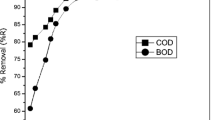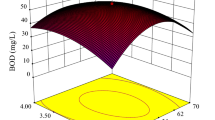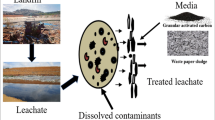Abstract
The present paper deals with the determination of pollutant removal efficiency of date pit-activated carbon (DPAC) from petroleum industry wastewater in a continuously operating inverse fluidized bed (IFB). The effect of physical and operating parameters of the adsorption process on total organic carbon (TOC), biological oxygen demand (BOD) and chemical oxygen demand (COD) of the petroleum wastewater were investigated through rigorous experimentation (184 data sets). The pollutant removal efficiency was found to be highly satisfactory with more than 95% reduction in COD, BOD and more than 88% reduction in TOC achieved under optimum condition within 160 min of wastewater circulation time through inverse fluidized DPAC bed. Three empirical correlations for percentage reductions of TOC, BOD and COD as a function of eight different physical and operating parameters were developed by dimensional analysis and the exponents were evaluated using 92 assorted experimental data and validated by the residual 92 data. The empirical equations developed were found to be well applicable within the range of dimensionless parameters \({Ar}_{m}\), \({Re}_{p}\), (\({\rho }_{l}/{(\rho }_{l}-{\rho }_{p}))\) and the dimensionless bed height of 1.663 to 55.4211, 0.1089 to 2.8181, 3.8644 to 4.3137 and 25.423 to 36.0169, respectively.













Similar content being viewed by others
Abbreviations
- AC:
-
Activated carbon
- v l (LT− 1):
-
Actual velocity
- BOD (ppm):
-
Biological oxygen demand
- h bi (m):
-
Bed expansion
- COD (ppm):
-
Chemical oxygen demand
- t c (T):
-
Contact time
- t cdim = \(\frac{{\mu }_{l} {t}_{c}}{{d}_{p}^{2}{(\rho }_{l}-{\rho }_{s})}\) :
-
Dimensionless circulation tank
- \({{h}_{b}}_{dim}= \frac{{h}_{bi}}{{d}_{p}}\) :
-
Dimensionless initial bed height
- DPAC:
-
Date pit-activated carbon
- g (LT− 2):
-
Gravitational acceleration
- IFB:
-
Inverse fluidized bed
- \(Ar_{m}= \frac{{ dp^{3} \left( {\rho l - \rho_{s} } \right)^{2} g}}{{\mu l^{2} }}\) :
-
Modified Archimedes number
- \({\mathrm{Re}}_{p}\) :
-
Modified Reynolds number
- F NET :
-
Net force
- dp (L):
-
Particle diameter
- \({\text{Re}}_{p} = \frac{{dp (\rho l - \rho_{s} )^{ } v_{s} }}{{ \mu_{l} }}\) :
-
Particle Reynolds number
- PBOD :
-
Percentage BOD
- PCOD :
-
Percentage COD
- PTOC :
-
Percentage TOC
- v s (LT− 1):
-
Superficial velocity
- h s :
-
Static bed
- T c (T):
-
Time for complete cycle
- TOC (ppm):
-
Total organic carbon
- t c (sec):
-
Time of recirculation
- v t (L):
-
Total volume of wastewater in the feed wastewater tank
- \({\Delta \rho }_{dim}=\) \(\frac{{\rho }_{l} }{{{\rho }_{l}}- {\rho }_{s}}\),:
-
Dimensionless density difference
- ρ l (ML− 3):
-
Liquid density
- µ l (ML− 1T− 1):
-
Liquid viscosity
- ρ s (ML− 3):
-
Particle density / Solid density
References
Yousef, R.; Qiblawey, H.; El-Naas, M.H.: Adsorption as a process for produced water treatment: a review. Processes. 8, 1–22 (2020). https://doi.org/10.3390/pr8121657
Al Jabri, F.; Muruganandam, L.; Aljuboury, D.A.D.A.: Treatment of the oilfield-produced water and oil refinery wastewater by using inverse fluidization-a review. Global Nest Rev 21, 204–210 (2019). https://doi.org/10.30955/gnj.002975
El-Naas, M.H.; Al-Zuhair, S.; Alhaija, M.A.: Evaluation of an activated carbon packed bed for the adsorption of phenols from petroleum refinery wastewater. Environ. Sci. Pollut. Res. 24, 7511–7520 (2017). https://doi.org/10.1007/s11356-017-8469-8
Aljuboury, D.A.D.A.; Palaniandy, P.; Abdul Aziz, H.B.; Feroz, S.A.D.A.: Treatment of petroleum wastewater by conventional and new technologies—a review. Glob. Nest J 19(3), 439–452 (2017). https://doi.org/10.30955/gnj.002239
El-Nass, M.H.; Al-Zuhair, S.; Alhaija, M.A.: Reduction of COD in refinery wastewater through adsorption on date-pit activated carbon. J. Hazard. Mater. 173, 750–757 (2010). https://doi.org/10.1016/j.jhazmat.2009.09.002
Sueyoshi, M.; Al-Maamari, R.S.; Jibril, B.; Tasaki, M.; Okamura, K.; Kuwagaki, H.; Yahiro, H.; Sagata, K.; Han, Y.: Preparation and characterization of adsorbents for the treatment of water associated with oil production. J. Anal. Appl. Pyrolysis. 97, 80–87 (2012). https://doi.org/10.1016/j.jaap.2012.04.003
Kulkarni, S.J.; Goswami, A.K.: Adsorption studies for organic matter removal from wastewater by using bagasse Fly ash in Batch and Column Operations. Inter. J. Sci. Res. 2, 180–183 (2013)
Tanweer, A.; Mohammad, D.; Mohammad, R.; Arniza, G.; Othman, S.; Rokiah, H.; Mohamad, N.; Mohamad, I.: The use of date palm as a potential adsorbent for wastewater treatment: a review. Environ. Sci. Pollut. Res. 19, 1464–1484 (2012). https://doi.org/10.1007/s11356-011-0709-8
Daniel, V.V.; Gulyani, B.B.; Prakash Kumar, B.G.: Usage of date stones as adsorbents: a review. J. Dispers. Sci. Technol. 33(9), 1321–1331 (2012). https://doi.org/10.1080/01932691.2011.620532
Gupta, V.K.: Suhas: application of low-cost adsorbents for dye removal—a review. J. Environ. Manag. 90, 2313–2342 (2019). https://doi.org/10.1016/j.jenvman.2008.11.017
Karunya, S.; Feroz, S.; Al Harassi, S.; Kishore, S.: Treatment of Oman pharmaceutical industry wastewater using low-cost adsorbents. J. Multidiscipl. Eng. Sci. Technol. 2, 339–341 (2015)
Karunya, S., Prakas, S.J., Parthaprathim, G., Sheik, F.: Application of response surface methodology for optimizing processing conditions for the adsorption of pollutants from refinery effluent of Oman. Res. J. Biotechnol. 16, 55–65 (2021)
Yakubu, M.K.; Gumel, M.S.; Abdullahi, A.M.: Use of activated carbon from date seeds to treat textile and tannery effluents. African J. Sci. Technol. 9, 39–49 (2008)
Bimal, D.; Uma Prasad, G.; Sudip Kumar, D.: Inverse fluidization using non-Newtonian liquids. Chem. Eng. Process. Process Intensif. 49, 1169–1175 (2010). https://doi.org/10.1016/j.cep.2010.08.018
Ulaganathan, N.; Krishnaiah, K.: Hydrodynamic characteristics of two-phase inverse fluidized bed. Bioprocess Eng. 15, 159–164 (1996). https://doi.org/10.1007/BF00369620
Safari, G.H.; Yetilmezsoy, K.; Mahvi, A.H.; Zarrabi, M.: post-treatment of secondary wastewater treatment plant effluent using a two-stage fluidized bed bioreactor system. J. Environ. Health Sci. Eng. 11, 1–9 (2013). https://doi.org/10.1186/2052-336X-11-10
Haribabu, K.; Sivasubramanian, V.: Biodegradation of organic content in wastewater in fluidized bed bioreactor using low-density biosupport. Desalin. Water Treat. 57, 4322–4327 (2016). https://doi.org/10.1080/19443994.2014.992978
Haribabu, K.; Sivasubramanian, V.: Treatment of wastewater in fluidized bed bioreactor using low density biosupport. Energy Proc. 50, 214–221 (2014). https://doi.org/10.1016/j.egypro.2014.06.026
Al Jabri, F.; Muruganandam, L.; Aljuboury, D.A.D.A.: Treatment of the oilfield-produced water and oil refinery wastewater by using inverse fluidization-a review. Global Nest Rev. 21, 204–210 (2019). https://doi.org/10.30955/gnj.002975
Rajasimman, M.; Karthikeyan, C.: Aerobic digestion of starch wastewater in fluidized bed bioreactor with low density biomass support. J. Hazard. Matter 143, 82–86 (2007). https://doi.org/10.1016/j.jhazmat.2006.08.071
Sokol, W.; Korpal, W.: Determination of the optimal operational parameters for a three-phase fluidized bed bioreactor with a light biomass support when used in treatment of phenolic waste waters. Biochem. Eng. J 20, 49–56 (2004). https://doi.org/10.1016/j.bej.2004.02.009
Sokol, W.: Treatment of refinery wastewater in a three-phase fluidized bed bioreactor with a low-density biomass support. Biochem. Eng. J. 15, 1–10 (2003). https://doi.org/10.1016/S1369-703X(02)00174-2
Amaiz, C.; Elmaleh, S.; Martinez, L.J.; Moletta, R.: Start-up of an anaerobic inverse turbulent bed reactor fed with wine distillery wastewater using pre-colonised bioparticles. Water Sci. Technol. 51, 153–158 (2005). https://doi.org/10.2166/wst.2005.0019
Garcfa-Bernet, D.; Buffiere, P.; Elmaleh, S.; Moletta, R.: Application of the down-flow fluidized bed to the anaerobic treatment of wine distillery wastewater. Wat. Sci. Tech. 38, 393–399 (1998). https://doi.org/10.1016/S0273-1223(98)00716-1
Arnaiz, C.; Buffiere, P.; Elmaleh, S.; Lebrato, J.; Moletta, R.: Anaerobic digestion of dairy wastewater by inverse fluidization: the inverse fluidized bed and the inverse turbulent bed reactors. Environ. Technol. 24, 1431–1443 (2003). https://doi.org/10.1080/09593330309385687
Hummadi, K.K.; Luo, S.; He, S.: Adsorption of methylene blue dye from the aqueous solution via bio-adsorption in the inverse fluidized-bed adsorption column using the torrefied rice husk. Chemosphere 287, 131907 (2022). https://doi.org/10.1016/j.chemosphere.2021.131907
Begum, S.; Sikkandar, M.Y.; Prakash, N.B.; Bakouri, M.; Alanazi, A.B.; Alkhatlan, N.M.S.: Investigation of flow dynamic characteristics of inverse fluidized bed biofilm reactor for degrading pharmaceutical based biomedical wastewater. Environ. Eng. Res. 26, 1–8 (2021). https://doi.org/10.4491/eer.2020.182
Yang, H.; Fan, M.; Liu, A.; Dong, L.: General formulas for drag coefficient and settling velocity of sphere based on theoretical law. Int. J. Min. Sci. Technol. 25(2), 219–223 (2015). https://doi.org/10.1016/j.ijmst.2015.02.009
Menya, E.; Olupot, P.W.; Storz, H.; Lubwama, M.; Kiros, Y.: Production and performance of activated carbon from rice husks for removal of natural organic matter from water: a review. Chem. Eng. Res. Design. 129, 271–296 (2018). https://doi.org/10.1016/j.cherd.2017.11.008
Salmana, J.M.; Njokua, V.O.; Hameeda, B.H.: Bentazon and carbofuran adsorption onto date seed activated carbon Kinetics and equilibrium. Chem. Eng. J. 173, 361–368 (2011). https://doi.org/10.1016/j.cej.2011.07.066
Al-Mutairi, N.Z.: 2,4-Dinitrophenol adsorption by date seeds: Effect of physico-chemical environment and regeneration study. Desalination 250, 892–901 (2010). https://doi.org/10.1016/j.desal.2008.10.035
Acknowledgements
The authors would like to acknowledge the support provided by the National United Dates Company L.L.C, Oman Oil Refineries and Petroleum Industries Company, SAOC (ORPIC). They would also like to thank National University of Science and Technology (NUST), Muscat, Oman and National Institute of Technology Durgapur, India.
Author information
Authors and Affiliations
Corresponding author
Ethics declarations
Conflict of interest
The authors declare that they have no conflict of interest.
Rights and permissions
About this article
Cite this article
Sakhile, K., Sarkar, J.P., Gupta, P. et al. Removal of Major Pollutants from Petroleum Wastewater by Adsorption with Activated Carbon Derived from Date Seed in an Inverse Fluidized Bed. Arab J Sci Eng 48, 8557–8569 (2023). https://doi.org/10.1007/s13369-022-07109-5
Received:
Accepted:
Published:
Issue Date:
DOI: https://doi.org/10.1007/s13369-022-07109-5




